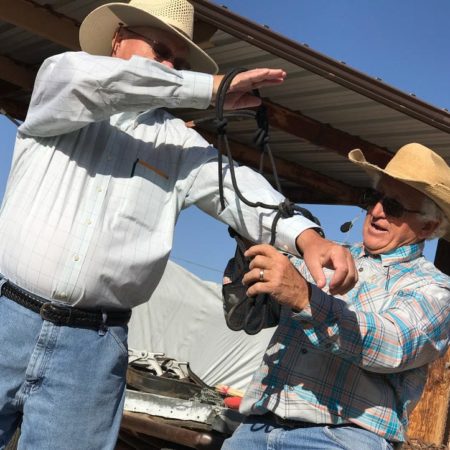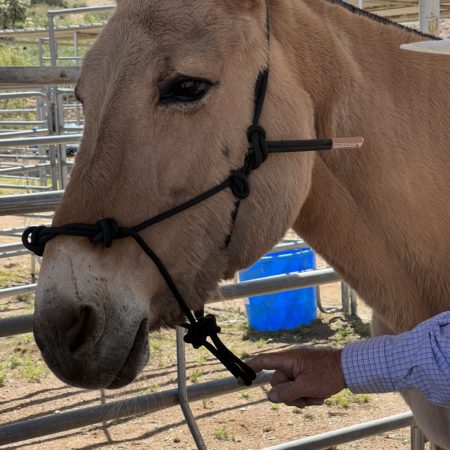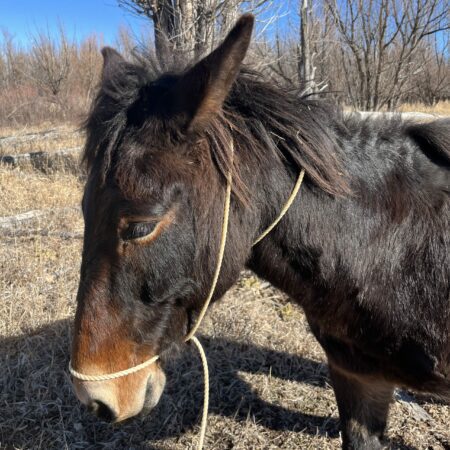Owning a Mule: We Are Not Desensitizing, We Are Halter Training
Steve Edwards: Use about three to four foot of rope. Try not to get in their space that way. Again, we’re not desensitizing. We’re halter training, where they stand still with the halter. Not to be worried about a barrel or something black, has nothing to do with it. There, much better. Two of you did awesome. You see how they pay more attention to their lead rope than they do your words? That’s good. Awesome. Very good. Okay, now just kind of walk them in and out of these buckets here.
Yeah. Like about three foot of rope. Maybe four foot of rope. They need to follow the looseness of the rope. Nice and quiet. No pressure on the rope at all.
Anytime they get too close, wiggle the rope. You’re going to lead them in through here. You’re going to stop them right there. Then you’re going to come over and ask them to come ahead, come ahead. Kind of turn around in here. Just kind of a tight, little turn. Give you about this much to start with. Make your turn and have him come on out. But you’re going to have them go slow. You can go right on out, but the idea is to have them do it as you cue them to pick up the next foot to make the turn. Okay? There you go. That a girl. Good for you.
You don’t have to be strong enough, but you need to be bumping, not pulling. Okay? Now, as you’re doing it, then start. Throw the rope out this way. Okay? Now come this way as you’re doing it. That’s okay. You just keep at it. Now just wait a second now. Wait right there. She’s licking her lips. Now, let’s lower the lead rope down. Lower the halter rope down so it goes a little bit lower on the nose. Okay? So what you’re going to do is you’re going to do this here. You’re going to pull up on it and push down. Bring the whole thing down so it’s completely around the nose, or otherwise, it was pulling way back up in here.
Now it’s rounded around the nose. Okay? Now turn your hand around. There you go. See how that made a difference?
When you change the come-along hitch, that then will give you a little bit more communication. There you go. There you go. There you go. Now, if I wouldn’t allowed you to make a mistake with the come-along hitch, you wouldn’t have learned that little spot right there. Right?
Now let’s look at how important this is. It’s natural to want to say, “Hold.” Try to do it with your hands as much as possible with your lead rope. Now, what we did is we readjusted the come-along hitch to where it’s more rounded around the nose, and it was touching the whole nose. Roll your wrist and walk as you’re going. There you go. Keep on coming. Keep on coming. That a girl. Walk as you go, as she’s … There you go. Very good. Very nice.
Sue: Okay, but when she turned to come out, she came out quick.
Steve Edwards: Now it’s going to be up to you to wiggle the rope to have her come down slow. Good, good. Oh, she’s listening to you nice now. Yes. Yes. Yes. Look at you. There. Now, you see here, what we had, John, what we had, Sue, we had the come-along on, but we didn’t have it adjusted where it had refined touch. Sue was beating herself to death. She says, “I don’t feel like I’m strong enough.” Exactly. With the come-along hitch, you don’t have to be strong, but you want to make sure it’s adjusted correctly. What was happening was, it was like this. It was way up here, high up on the jaw right here. It wasn’t doing much good.
As she was pulling, it was pulling on the jaw and not on the nerves underneath the chin. Okay? This is what you do. You pull up on it, push down, and bring it down around here like this. Pull up on it, push down, bring it down around so it stays rounded above the nose and two fingers above the nostril. Just like that. What happens is, especially when we start doing a lot of pulling, pretty soon, the thing starts climbing up the face. Now don’t use your strength. Just use your, roll your wrist. Now when you go out, go out and come back to the right.
Sue: Instead of going to the left?
Steve Edwards: Yes ma’am.
Sue: Go through it the same, but come left?
Steve Edwards: Yes ma’am. Let’s adjust the nose piece. It kind of comes lose a little bit. There you go. Pick up on it, and then tighten it up. There you go. Two fingers above the nostril. There you go. Get your hand correct. Good. Always remember, our hand, we need to roll the wrist. Good. Nice. Nice. Nice. Stop, stop, stop, stop, stop. Get after him.
Sue: I was actually letting her … I mean.
Steve Edwards: Exactly right. Okay, go back around. Do it again.
Sue: You want me to stop there?
Steve Edwards: Yes ma’am. Well, don’t let her rush out and push on you, because see? She was on top of you.
Sue: Okay.
Steve Edwards: It wasn’t so much she was moving fast, but she was on top of you. She was more interested in getting out of there. You just kind of slow her up and get after her. There you go. There you go. There you go. There you go. Just roll your wrist and move at the same time. That a girl. Yes. And move at the same time. Yes. Look at you. Yes. Good for you. Yes. Oh, much better. Now that mule’s listening to you. Yes. Yes. Very good. Look at that. Good. Good. Now, here’s what you were doing before. Hold on to the rope with your hand. Okay? You were doing this, using your weight
Sue: Right.
Steve Edwards: Hold on to it. You were using your weight. Use your hand. Feel the difference?
Sue: Yep.
Steve Edwards: Feel this compared to this?
Sue: Yep.
Steve Edwards: What are you doing here? You’re pulling. What are you doing here?
Sue: Tugging.
Steve Edwards: Bumping. You don’t have to use strength. You don’t need muscles. Okay? You just need to roll your wrist. Bump, bump, bump. When you’re here like this, you’re trying to brace him. They’ll brace right against you.
-
 Mule Ground Foundation Starting KitRated 5.00 out of 5 based on 12 customer ratings
Mule Ground Foundation Starting KitRated 5.00 out of 5 based on 12 customer ratings -

 Rope HalterRated 4.88 out of 5 based on 32 customer ratings
Rope HalterRated 4.88 out of 5 based on 32 customer ratings -

 Come-A-Long RopeRated 4.99 out of 5 based on 69 customer ratings
Come-A-Long RopeRated 4.99 out of 5 based on 69 customer ratings
- Posted in: Everything, Videos
- Tagged: Everything, Videos


